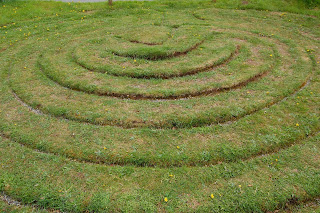I have visited this particular labyrinth several times, this picture shows it the first time I saw it, in the snow after climbing up to the Castle Howard pyramid some years ago. The drive to the labyrinth was ridiculous, we could barely stay clinging to the road and you couldn't tell which part was road and which was field. We found it up a slippery hill eventually, on a verge between two tiny villages. We stayed as long as we could in thefreezing cold, partly because the glittering undulations on the snowy path of the labyrinth was unbearably pretty in the moonlight, and partly because we knew we had to drive back down the slippy hill to possible death.
As I'm not a dowser I can't say if the labyrinth had given me any signs of being inauthentic but perhaps the pilgrimage to the site endowed it with some kind of myth that might not have previously been there had we chanced upon it by mistake.
My second visit to Dalby was a few years later, all being opposite, around midsummer. I think turf labyrinths are intended to be visited in the summer months, for one it probably doesn't do them any good walking them when the grass is at it's low ebb.
The labyrinth was much easier to get to, although still quite good at hiding on the side of the road.
The game of troy being linked with Scandinavia in the information given at the site is interesting, I always liked the Scandinavian folklore of stone labyrinths being used to trap malevolent spirits before voyages, the sailors would run to the centre of a labyrinth and then jump out, leaving the spirit behind. The game of troy pictured on the Tragliatella wine-server seems to show one of the riders leaving the maze carrying a strange, wizened creature:
The strange creature riding out doesn't seem to be off-putting for the couples on the other side of the picture, so perhaps it isn't intended to be as hideous as it turned out.
The thought that the authenticity of an ancient site comes with some kind of curse, a spirit that follows you home, is not unknown to me. At the very least, spending long periods of time in an ancient, inhabited cave meant I took home a number of gigantic cave spiders in my backpack. To be on the safe side, I suggest leaping from the centre of any labyrinth you walk, even Saffron Walden, to make sure nothing follows you home.
I'm always interested to see labyrinths put to use, this webpage shows the Whitewater Mesa labyrinth, walked on horseback.



















g!Wk~%24(KGrHgoOKjUEjlLmTEG6BKpzcn6wsw~~_35.jpg)